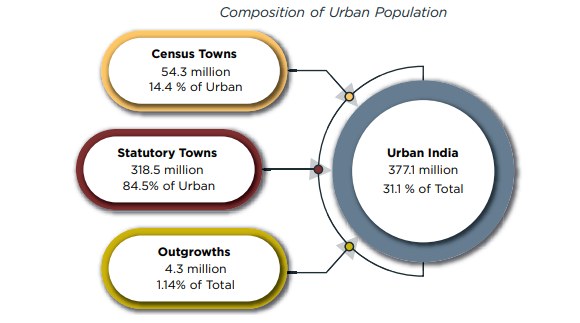Governance
Urban Planning Reforms: NITI Aayog
- 18 Sep 2021
- 7 min read
Why in News
Recently, NITI Aayog has launched the report titled ‘Reforms in Urban Planning Capacity in India’.
Key Points
- Urbanisation in India:
- Urbanisation Level (National):
- India’s population stood at 1210 million in 2011, with an urbanisation level of 31.1% (Census of India 2011).
- Urbanisation is an increase in the number of people living in towns and cities.
- The distribution of urban centres and the pace of urbanisation is not uniform across the country.
- Over 75% of the urban population of the country is in 10 States: Maharashtra, Uttar Pradesh, Tamil Nadu, West Bengal, Andhra Pradesh, Gujarat, Karnataka, Madhya Pradesh, Rajasthan, and Kerala.
- India’s population stood at 1210 million in 2011, with an urbanisation level of 31.1% (Census of India 2011).
- State-wise Scenario:
- Above National Average: Goa, Tamil Nadu, Kerala, Maharashtra, and Gujarat have attained over 40% urbanisation.
- Below National Average: Bihar, Odisha, Assam, and Uttar Pradesh continue to be at a lower level of urbanisation than the national average of 31.1%.
- Union Territories: NCT of Delhi, Daman and Diu, Chandigarh, and Lakshadweep, show above 75% urbanisation.
- Urbanisation Level (National):
- Need for Reforming Urban Planning Capacity:
- Increasing Urbanisation: India’s urban population is 11% of that of the world.
- However, in absolute numbers, the urban population in India is more than highly urbanised countries/regions like the United States, Japan, Western Europe, and South America.
- During 2011-36, urban growth will be responsible for 73% of the rise in total population in India.
- Urbanisation is Central to India’s Economy: Urbanisation contributes nearly 60% to India’s Gross Domestic Product (GDP).
- However, there exists large, untapped economies of scale.
- India’s National Growth Targets:.
- Economic Growth Target: USD 5 trillion economy by 2024.
- Employment Target: Total workforce estimated to be 0.64 billion by 2030, of which 0.26 billion to be employed in urban areas.
- Infrastructure Targets: Creation of 11 large industrial corridors as part of the National Industrial Corridor Programme, several multi-modal logistic parks, etc.
- Environmental Protection Targets: River rejuvenation, clean air in cities, etc.
- National Infrastructure Pipeline (NIP): The urban sector has a significant share of 17% in the NIP.
- NIP facilitates infrastructure projects in the country with a projected investment of Rs 111 lakh crore during the period 2020-25.
- India’s Global Commitments:
- SDGs (Goal 11): Promote urban planning as one of the recommended methods for achieving sustainable development.
- UN-Habitat’s New Urban Agenda: It was adopted at Habitat III in 2016. It puts forth principles for the planning, construction, development, management, and improvement of urban areas.
- UN-Habitat (2020) mentions spatial sustainability, as a concept. It suggests that the spatial conditions of a city can enhance its power to generate social, economic and environmental value and well-being.
- Paris Agreement: India’s National Determined Contributions (NDCs) includes the goals to reduce the emission intensity of the country's GDP by 33 to 35% by 2030 from 2005 level.
- Increasing Urbanisation: India’s urban population is 11% of that of the world.
- Recommendations:
- Planning of Healthy Cities: Central Sector Scheme ‘500 Healthy Cities Programme’, for a period of 5 years, wherein priority cities and towns would be selected jointly by the states and local bodies.
- The Programme can lead to optimum utilization of urban land as well.
- Re-engineering of Urban Governance: To bring in more institutional clarity and also multi-disciplinary expertise to solve urban challenges.
- The formation of an apex committee at the state level is recommended to undertake a regular review of planning legislations (including town and country planning or urban and regional development acts or other relevant acts).
- Strengthening the Role of the Private Sector: These include the adoption of fair processes for procuring technical consultancy services, strengthening project structuring and management skills in the public sector, and empanelment of private sector consultancies.
- Measures for Strengthening Human Resource and Match Demand–Supply: The constitution of a ‘National Council of Town and Country Planners’ as a statutory body of the Government of India.
- Also, a ‘National Digital Platform of Town and Country Planners’ is suggested to be created within the National Urban Innovation Stack of MoHUA.
- Citizen Outreach Campaign’ for demystifying urban planning.
- Strengthening Urban Planning Education System.
- Planning of Healthy Cities: Central Sector Scheme ‘500 Healthy Cities Programme’, for a period of 5 years, wherein priority cities and towns would be selected jointly by the states and local bodies.
Schemes/Programmes Related to Urban Development
- Smart Cities: To promote cities that provide core infrastructure and give a decent quality of life to its citizens, a clean and sustainable environment and application of Smart Solutions.
- AMRUT Mission: To ensure that every household has access to a tap with the assured supply of water and a sewerage connection.
- Swachh Bharat Mission-Urban: Aims at making urban India free from open defecation and achieving 100% scientific management of municipal solid waste in 4,041 statutory towns in the country.
- HRIDAY: The National Heritage City Development and Augmentation Yojana (HRIDAY), aims to bring together urban planning, economic growth and heritage conservation in an inclusive manner & with the objective of preserving the heritage character of the City.
- Pradhan Mantri Awas Yojana-Urban: Addresses Urban housing shortage among the Urban Poor including the Slum Dwellers by ensuring a pucca house to eligible urban poor.





